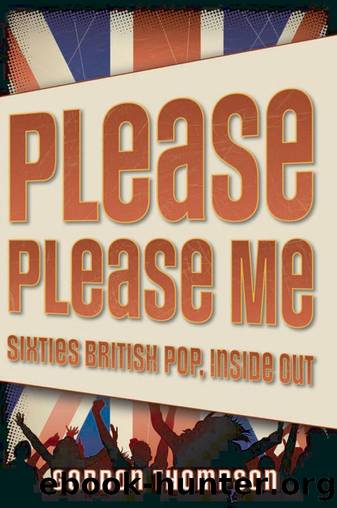Please Please Me by Gordon Thompson;

Author:Gordon Thompson;
Language: eng
Format: epub
Publisher: OUP Premium
Published: 2008-06-15T00:00:00+00:00
GEOFF STEPHENS
The epitome of the Denmark Street professional, Geoff Stephens (b. 1934) provides an example of the artistically promiscuous craftsman on that short block. In the sixties, he co-wrote with John Carter, Roger Greenaway, Les Reed, Peter Callander, Barry Mason, Ken Howard, Alan Blaikley, Don Black, Mitch Murray, and Tony Macaulay and penned some of his most successful songs independently. Never a public performer, Stephens helped to manage, promote, and produce both Donovan (e.g., âCatch the Windâ), in the early stages of the Scottish singerâs professional career, and one of the more unusual performance eccentricities of the sixties: the New Vaudeville Band. Although few outside the industry know his name, the sixties would not have been the same without him.
As a child and adolescent, Stephens had dabbled at an auntâs piano and âloved the sound that came from it,â but received no formal musical training. When the war ended, his family moved to the mouth of the Thames: in Westcliff-on-Sea (near Southend-on-Sea), they opened a guesthouse. Perhaps most important, in addition to the BBC, their location on Britainâs east coast enabled them to pick up American Forces Network broadcasts from Germany and Radio Luxembourg. This environmentâmusic programs of jazz, American pop, and classical music on the family radio and in the resort townâs cafesâleft Stephens in love with music.
The catalyst for Stephens came in the form of an inspiring high school teacher: âFrom that point on, I decided I wanted to be a writer; [but] I didnât know what kind.â After a two-year Middle East stint in the national service, Stephens steered his interest toward music and poetry, and began to seek ways to support himself and his young wife. He remembers that he âloved pop music: loved it to death,â and set himself a goal of âthree years to be a songwriter.â First, however, he needed an income and found various occupations that allowed him âenough time to write the songsâ and âto go to London and get them published, not to mention establishing contacts.â
In an age when sheet music sales still constituted a significant part of a songwriterâs income, and when publishers thought of music primarily in terms of the printed page, Stephens entered the fray at a distinct disadvantage: he had never learned how to read music. In the mid-1950s, the most common way for a young songwriter to bring material to a publisherâs attention involved notation; consequently, Stephens engaged the assistance of musical professionals: âI used to take these musical journals and put an advert in saying, âSongwriter wishes services of a trade musician.â I got guys to do that for me and I paid them, albeit what I could afford.â His method consisted of singing to the musician, who would transcribe the music he heard. What Stephens could not sing was the harmonic structure of the song; that he left to a discovery process with the musician:
There was a guy in the pit orchestra in the Palladium who used to take down my songs. Iâd sing [and] he said, âWhatâs the chord?â I said, âI donât know anything about chords.
Download
This site does not store any files on its server. We only index and link to content provided by other sites. Please contact the content providers to delete copyright contents if any and email us, we'll remove relevant links or contents immediately.
The Social Psychology of Inequality by Unknown(2989)
Make Comics Like the Pros by Greg Pak(2883)
Stacked Decks by The Rotenberg Collection(2843)
Purple Hibiscus by Chimamanda Ngozi Adichie(2740)
The Queen of Nothing by Holly Black(2543)
The Art of Doom by Bethesda(2131)
Life of Elizabeth I by Alison Weir(2052)
Putin's Labyrinth(1986)
The Power of Habit: Why We Do What We Do in Life and Business by Charles Duhigg(1970)
Drawing Down the Moon by Margot Adler(1844)
Things Are What You Make of Them: Life Advice for Creatives by Adam J. Kurtz(1835)
Agency by William Gibson(1800)
Wall and Piece by Banksy(1797)
Art Of Atari by Tim Lapetino(1771)
Teaching to Transgress: Education as the Practice of Freedom (Harvest in Translation) by Bell Hooks(1741)
The Beatles Lyrics by Hunter Davies(1694)
The Pin-Up Art of Bill Ward by Bill Ward(1674)
Only What's Necessary: Charles M. Schulz and the Art of Peanuts by Chip Kidd(1667)
The Andy Warhol Diaries by Andy Warhol(1576)
